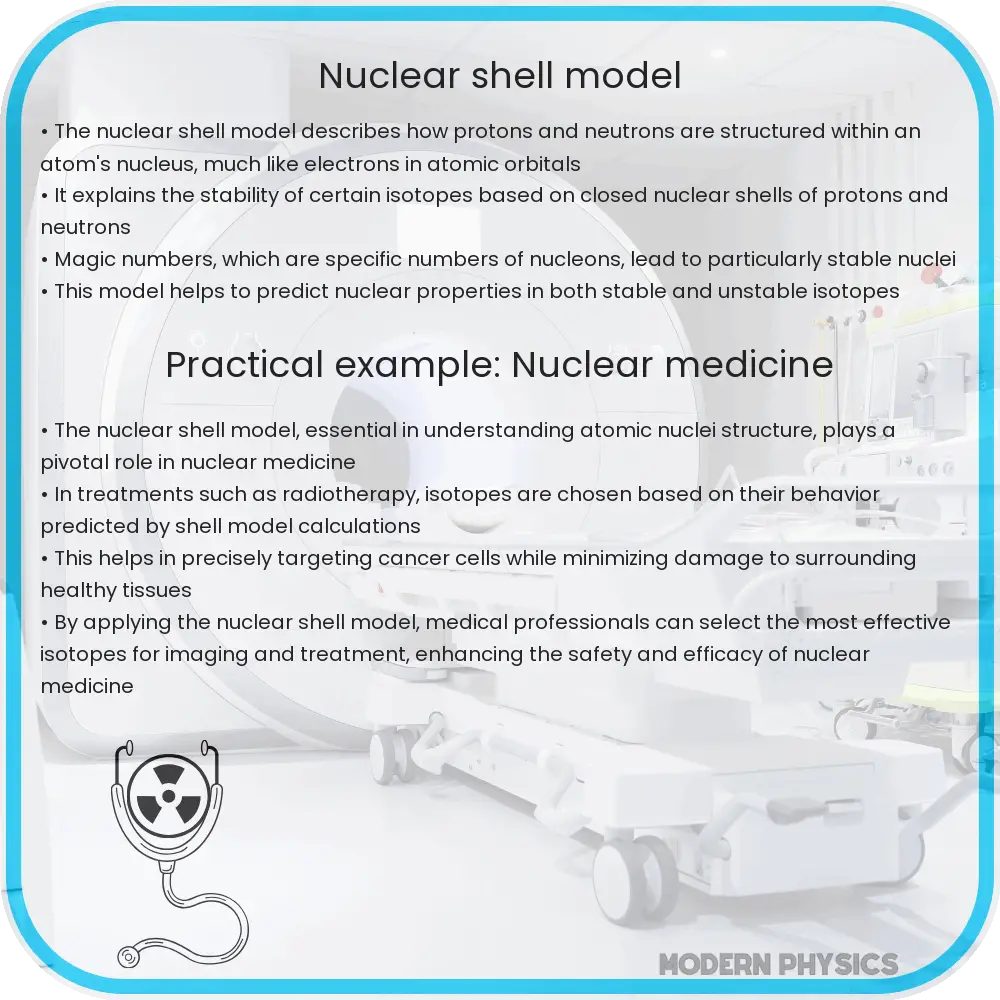Learn about the nuclear shell model, which explains the organization and behavior of protons and neutrons in atomic nuclei using quantum mechanics principles.

Introduction to the Nuclear Shell Model
The nuclear shell model is a fundamental concept in nuclear physics, providing a framework for understanding the structure and behavior of atomic nuclei. Much like electrons in an atom, protons and neutrons (nucleons) within a nucleus are thought to occupy discrete energy levels or “shells. This model helps explain various nuclear properties, including the stability of isotopes and the reasons behind magic numbers in nuclei.
Principles of the Nuclear Shell Model
The nuclear shell model is primarily based on the quantum mechanics principle that particles like nucleons can occupy certain quantized states. The model applies a similar approach to that used in the electronic configuration of atoms but adapted to the complexities of nuclear forces. Here are some of the key principles and features of the nuclear shell model:
- Quantum States: Nucleons are arranged in shells and subshells based on their quantum numbers. These quantum numbers include the principal quantum number (n), orbital angular momentum (l), magnetic quantum number (m), and spin quantum number (s).
- Pauli Exclusion Principle: This principle states that no two identical fermions (particles like protons and neutrons with half-integer spin) can occupy the same quantum state simultaneously. This principle is crucial for determining the arrangement of nucleons in a nucleus.
- Nuclear Spin: The overall spin of a nucleus is determined by the spins and orbital angular momenta of the protons and neutrons occupying the outermost shells.
- Energy Levels: The energy levels in nuclei are not equidistant, unlike the simpler case of electrons in atoms. The nuclear potential is more complex, often modeled as a three-dimensional harmonic oscillator potential combined with a spin-orbit interaction term.
The magic numbers—2, 8, 20, 28, 50, 82, and 126—are particularly significant in the nuclear shell model. These numbers correspond to completely filled shells in the nucleus, leading to exceptionally stable configurations. For example, nuclei with a magic number of protons or neutrons exhibit greater stability and are less likely to undergo radioactive decay.
Development of the Model
The nuclear shell model was developed in the late 1940s and early 1950s by several physicists, most notably Maria Goeppert Mayer and J. Hans D. Jensen, who shared the Nobel Prize in Physics in 1963 for their contributions. Their work introduced a deeper understanding of the shell structure of nucleons, incorporating both the existing knowledge of nuclear phenomena and the advanced mathematical frameworks of quantum mechanics.
The initial models were simpler, focusing on the potential well created by the collective attraction among nucleons, treating it similar to the Coulomb potential influencing the electrons. However, these models evolved to account for the strong nuclear force and its properties, such as saturation and short range.
Applications of the Nuclear Shell Model
The nuclear shell model is not just a theoretical construct but has practical applications in various fields, including nuclear medicine, energy production, and astrophysics. By predicting the stability of isotopes, the model aids in the manufacturing of medical isotopes used in diagnostics and treatment. In nuclear energy production, understanding the stability of different nuclei helps in the selection of fuel and the management of nuclear waste. Additionally, the model provides insights into nucleosynthesis in stars, explaining the process of element formation under extreme conditions.
Challenges and Limitations
Despite its success, the nuclear shell model does have limitations. One significant challenge is its inability to accurately predict the properties of very heavy or exotic nuclei where the interaction between nucleons becomes more complex. Additionally, the model struggles with nuclei that are far from the line of stability, where the ratio of protons to neutrons is atypical. Advances in computational techniques and the development of more sophisticated models strive to overcome these challenges, offering a more comprehensive understanding of nuclear behavior.
Conclusion
The nuclear shell model has been a cornerstone in the field of nuclear physics, offering profound insights into the structure and stability of atomic nuclei. From its inception in the mid-20th century to its ongoing development, the model has not only elucidated many mysteries of nuclear chemistry and physics but also has provided a framework that supports various scientific and practical applications. Despite its limitations and the emergence of new modeling techniques, the nuclear shell model remains a vital tool for both theoretical studies and practical applications in today’s nuclear research. With the continuous refinement of the model and the integration of new data and technology, its role in enhancing our understanding of the atomic nucleus is undeniable.
